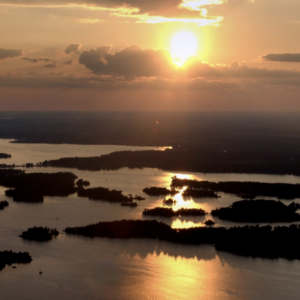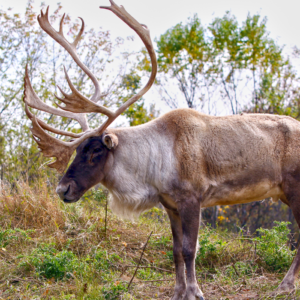A Warming Planet – Can Wildlife Keep up with the Changes?
This blog is written by Steve Gahbauer, who has been regularly contributing Nature Notes for many years.
It is undeniable that climate change is one of the greatest problems that we are facing around the world. It is redrawing the boundaries of where plants, animals and living organisms can survive. The problem is that not only is the climate changing but that it is changing so fast. Nature always adapts, but can it do so quickly enough? The fast global warming creates a whole host of problems affecting birds, mammals, amphibians, reptiles, aquatic creatures, insects and plants in different ways. Roughly half of all animal species are on the move. The average range of poleward shift for land-based species has been pegged at between six and 17 km per decade. Marine species are moving more than four times as fast.
The indirect impacts of shifting of species ranges are just as profound. Climate change is altering the distribution of malaria-transmitting mosquitoes, of insects that transmit the dengue and Zika viruses, and of various ticks. It also affects the determination of sex for animal offspring whose sex is determined by temperature. For Green Sea Turtles it is the temperature outside the egg that influences the sex of the growing embryo. This endangers their sex-balanced future ina warmer world. Some sea turtle populations are already so skewed by heat that the young reptiles are almost entirely female.
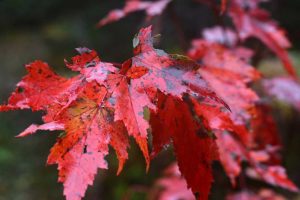
Maple Leaves, photo by Bea Gravelle.
Sugar Maples are also threatened by climate change. Warmer temperatures and dry conditions are a predicament for this drought-sensitive species. It has been observed that there is an earlier bud burst in Sugar Maples and an earlier flowering period for aspens. In fact, based on climate records from the previous 100 years, Canada’s growing season has increased considerably. Tree lines have also expanded upward and northward. Studies demonstrate that climate change has already an impact on Canada’s forests. As new species move into Canada, there’s always the risk of some of them being or becoming invasive. Just look at the Mountain Pine Beetle and the devastation it brought to British Columbia and Alberta forests, and the work of the destructive Spruce Bark Beetle in the Yukon. There is also the loss of aspens in the southern boreal forest and the western aspen parkland. The Gypsy Moth, a defoliating forest pest, is causing havoc in woodlands. The Kudzu plant, native to eastern Asia and introduced initially to the United States, is now spreading and taking over anything in its path.
Caribou were once one of Canada’s widespread animals, but today their numbers are dropping dramatically. Boreal caribou rely on the boreal forest and wetland ecosystems for survival. In northeastern Alberta, industrial activity has resulted in the destruction and fragmentation of boreal caribou habitat, which also increases wolf predation on caribou. Seven out of 12 boreal caribou herds in Alberta are already in decline.
If we want to keep this threatened species from continuing down the road to extinction, we need to protect its habitat and shield caribou from the effects of human industrial activities, as well as from the consequences of climate change. Global warming increases rainfall that freezes on the ground and blocks the growth of plants and lichen on which caribou feed. It also means more insect harassment, which interrupts feeding and drains caribou energies. Inadequate industrial development planning affects migratory habits and caribou calving grounds, leading to reduced birthrate and lower survival of the calves. Where migratory caribou herds live, the environment is changing fast.
There is no doubt that climate change is having a serious impact on wildlife. Will some species be able to change their habitat? Which animals might we find in our own backyard that we never expected? Just how dire will the future look for our beloved species?
One way for species to adapt is to shift or expand their range. There are many examples of species that are already on the move in response to climate change, or at least partially due to climate change. For instance, there are now Triggerfish (a tropical fish species) in Maritime waters, Giant Swallowtail Butterflies (once restricted to extreme southwestern Ontario) are now spreading northward in the province, and Blacklegged Ticks (deer ticks) are increasing their range in North America.
As temperatures warm it also brings other issues for many species. Gray Jays, for instance, don’t migrate and therefore stash food in the fall to help them through the winter. Warmer autumns are causing a lot of their stored food to decay before it freezes.
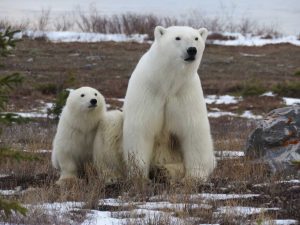
Polar Bear and Cub in Churchill Manitoba. Photo by Charmaine Paquette.
Arctic areas are warming quicker than other areas and sea ice melting along with glaciers and ice caps has far-reaching impacts. There is more at risk from a warming Arctic than just Polar Bears – there are also the Atlantic Walrus, Ringed Seals, Black Guillemots and many more that are affected.
Atlantic Walrus’ like to climb out on ice or islands. With climate change, many areas are now ice-free and with rising sea levels some islands are no longer above water. Climate change also brings with it another threat for this species – increased shipping and people – definite threats to this sensitive and easily disturbed animal.
Ringed Seals typically give birth in early April in areas that are dug in snowdrifts. But with warmer springs, these birth lairs can collapse, exposing the pups to predators, like Polar Bears.
Black Guillemots are birds of the northern seas. Arctic Cod was the preferred food for the parents to feed the chicks, but with Arctic Cod becoming scarce due to an increase in sea surface temperatures, chicks are now fed sculpin which doesn’t offer near the same amount of nourishment.
Not all species are able to move north and it seems that for many of them, even for those that can, climate change is happening too quickly for them to keep up. Even if they are able to expand their range, it doesn’t happen without consequences. Entering new territories could mean more competition for food and interactions with new species. Some species are already at their northern limit. Where would they go?
While some animals are able to respond to these changes, many species won’t be able to move fast enough, which may result in die-offs if they are not able to adapt in other ways. Even some birds and butterflies – mobile species – are not able to expand their ranges fast enough to keep up with the speed of climate change, and for some there may be nowhere else to go.
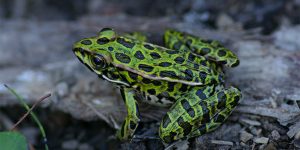
Northern Leopard Frog by Elena Kreuzbert
A warming planet changes the spread of invasive species (both animals and plants) and habitat loss threatens Canada’s ecologically significant species. Time is running out for the Northern Leopard Frog in the prairies and the Rocky Mountains; there are many more species of flora and fauna that are affected by global warming. We cannot continue to simply ignore climate change. Land degradation, biodiversity loss and climate change are three different faces of the same central challenge: the increasingly dangerous impact of our choices on the health of our natural environment. While global warming has happened in the past, it is – this time — hastened by human activities. It is up to us to slow it down and mitigate its impact. Wild species are worth protecting. Let’s remember that we have a responsibility to other creatures and to the planet. Let us all do our part.
Steve Gahbauer


